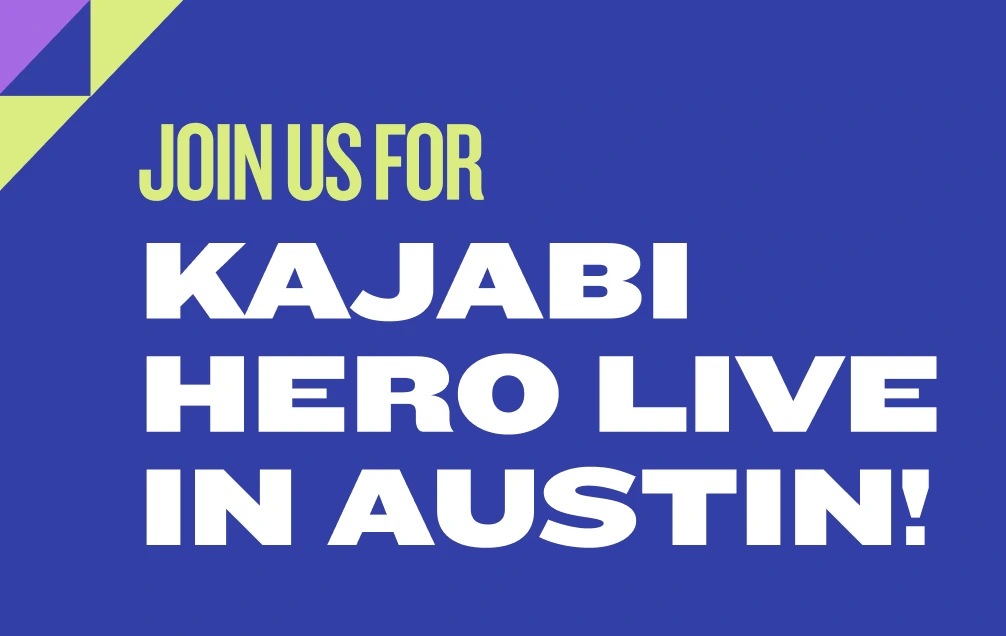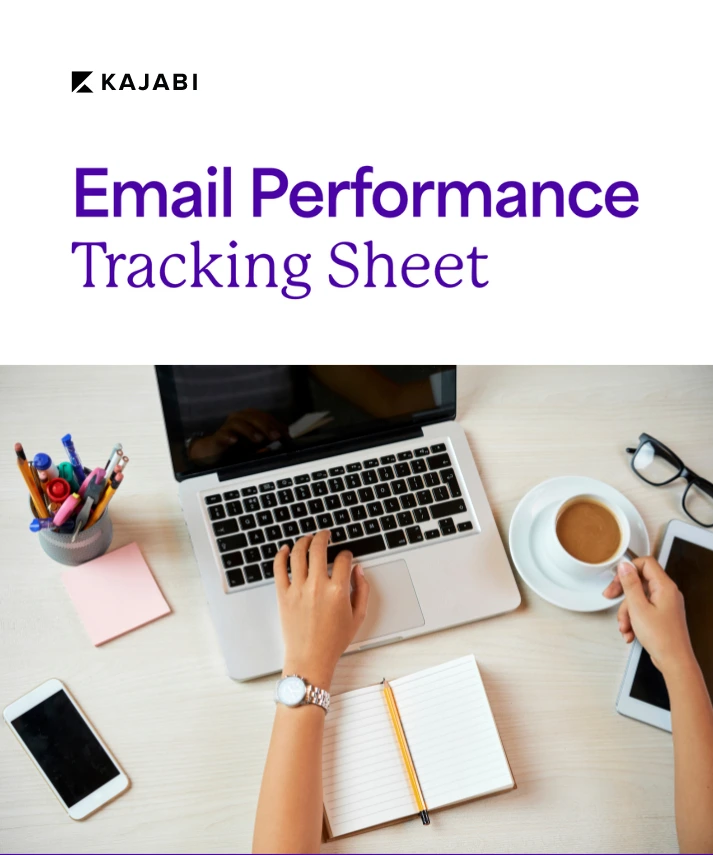
How to increase sales: 21 proven strategies to sell more online
Get free expert insights and tips to grow your knowledge business sent right to your inbox.
Let’s face it: Every entrepreneur wants to sell more products. This remains true of Knowledge Commerce professionals.
There’s no reason to feel guilty about it. You went into business to make money, so you need to boost sales if you want to increase revenue and profit.
It’s not entirely selfish, either. If you sell more products, you have more time and resources to spend on creating other products for your audience. After all, you’re selling your knowledge — something others want to buy.
However, figuring out how to increase sales isn’t always easy. Maybe you’ve already set up your Kajabi website, started a blog, and created landing pages. Where do you go next?
Or perhaps you’ve experienced sales growth before, but now sales have grown stagnant. You’re not seeing the same steady growth you enjoyed before. How can you regain your upward mobility?
We’re going to give you a hand. To help you increase sales, we’ve come up with 21 unique strategies to help maximize customers and profits alike.
Regardless of the niche or industry in which you work, each of these 21 selling hacks can help you increase sales. They also have the added benefit of helping you improve your brand equity and recognition among your audience.
1. Focus on Specific Benefits Instead of Features
Features and benefits sound like the same thing. They’re not.
A feature is a part of your product that provides value. It could be a series of videos, a specialized calculator, 15 minutes of one-on-one coaching, or an add-on e-book that you provide along with your online course.
Benefits, on the other hand, are direct consequences of those features. They go a step further and help your audience understand why those features prove so valuable.
For instance, maybe one of the features of your latest online course is an e-book that explains in detail a complex part of what you teach. That’s great!
But how do we turn it into a benefit?
You might say in your sales copy that the bonus e-book that ships with your course offers in-depth guidance on [topic] that will produce [result]. You fill in the blanks based on what you teach.
2. Know Your Customers

Your customers are your bread and butter. They’re the reason you’re in business.
Without them, you’re just talking to yourself. That’s why you need to get to know your customers via buyer personas.
Think of a buyer persona as a brief biography of your favorite fictional character. For instance, let’s say that your ideal customer looks a lot like Sheldon Cooper from “Big Bang Theory.”
Your buyer persona might look something like this:
“Sheldon is an upper-middle-class single professional in academia. He enjoys playing video games, challenging his friends to intellectual pursuits, and reading comic books. Sheldon is very set in his ways and prefers routine over spontaneity. When new technology debuts, he’s a first adopter.”
You can see how detailed buyer personas would help you target the right people, whether you’re hitting them with paid ads or using inbound marketing.
Businesses can have multiple buyer personas. Base them on demographics, age, gender, and other factors that influence buying decisions. One of your digital products might be geared toward Buyer Persona A, while another caters to Buyer Persona B.
3. Survey Your Audience
How do you get to know your audience? You ask them questions.
A semi-annual survey can help you keep your finger on the pulse of your customers. How have they changed? How have they stayed the same? What do they want you to create next?
You can use your email list to poll your audience. Ask them to answer a few questions — three to five is usually a healthy amount — and offer a special promotion for those who participate, such as a coupon code. When you incentivize participation, you’ll increase it.
Social media offers another opportunity to survey your audience. The more you know, the better you can make your products.
“Social media offers another opportunity to survey your audience. The more you know, the better you can make your products. #Kajabi” — Tweet this!
4. Upsell and Downsell Your Knowledge Commerce Products
Downselling sounds like a bad thing, but it’s not. Think of it this way: Would you rather a consumer buy your cheapest digital product or no product at all?
Most likely, you answered, “my cheapest product.”
Find a way to upsell and downsell your Knowledge Commerce products. A “Suggested Products” section on your sales pages can help enormously. Maybe a visitor can’t afford your $500 course, but would be more than willing to invest in your $99 mini course.
You can also upsell and downsell through email marketing. Suggest your most expensive course in an email, then add, “But Wait, That’s Not the Only Option.” List your less-expensive courses below that.
5. Invite Word-of-Mouth Advertising
Back in the day, word-of-mouth advertising meant just that. People would spread the word about products and services they loved during in-person conversations. And that still happens.
However, word-of-mouth now also takes place digitally. People recommend the products they love while chatting via text, communicating via email, and posting on social media.
To make sure they talk about your products, ask them to spread the word. If you specifically invite people to talk about your products, they’ll be more likely to share your creations with their networks.
Don’t forget about family and friends, either. Remind them every so often that you’re in business and looking for customers. That will keep you top-of-mind when they meet someone who might benefit from your products.
6. Promote a Limited-Time Offer

Consumers respond well to urgency. They have FOMO — fear of missing out — and they typically aren’t opposed to impulse purchases.
Think of limited-time offers in the context of the point-of-sale stations in retail stores. You’re waiting to check out with a basket full of goodies, then you notice a small, inexpensive product on a nearby shelf. You grab it, add it to your cart, and increase your total expenditure.
Limited-time offers also work well on television. Stations like QVC and HSN use it all the time. A countdown timer lets people know they must act before the products run out or the sale ends.
Do the same for your products. A limited-time promotion or sale can encourage impulse purchases.
7. Engage in Social Listening
Social listening is a practice that involves paying attention to social conversations online — primarily via social media. For instance, if someone mentions your name or brand on Facebook, you want to know about it.
Setting up Google Alerts is a great first step toward social listening. Every time your business’s name gets mentioned online, for instance, you’ll receive an email with a link to the page.
You can also follow branded hashtags as well as industry-related hashtags. Tools like Mention and Buzzsumo can automated the process and make it faster, but you can also do it manually if you’re on a budget.
What’s the point of social listening? You can jump into conversations about your brand or industry and send consumers to your landing pages.
8. Create a Rewards or Loyalty Program
People love to get rewarded for things they would do anyway, such as shop at the online stores of their favorite online merchants. You probably participate in a few rewards or loyalty programs yourself, such as with your local supermarket.
By setting up a loyalty program for your digital products, you encourage people to remain loyal to your brand and to buy from you more than once. Since they know they can receive a discount, for instance, on your latest online course simply because they’ve bought from you before, they’ll be more likely to click the “buy” button.
9. Give Away Your Best Stuff for Free
Many business owners avoid giving away valuable information because they don’t want to diminish their products’ value. However, you can actually boost your sales by giving away some of your best advice for free.
Think about it. If someone is willing to provide free secrets and insider tips, don’t you want to know what amazing value that person offers through paid products?
Additionally, generosity is a powerful motivator. People want to surround themselves with other people who give generously of their time and knowledge. Be that person if you need to give your sales a boost. You can give away this information through lead magnets, blog posts, infographics, and other content.
10. Build a Platform and a Voice

If you’re looking for the missing puzzle piece when it comes to sales figures, you might lack a brand or voice. Or, rather, you might lack control over your brand and voice.
Every entrepreneur has a brand. He or she also has a voice. If neither is carefully curated and designed to attract customers, however, it’s not doing its job.
Think about the people you follow online. What do you like about them? Why do you pay attention to their content instead of someone else’s?
Likely, it comes down to brand or voice — or both. You like the person’s values, beliefs, and style, or perhaps the person’s voice resonates with you in a unique way.
The more time you spend discovering your voice and promoting your brand consistently, the more sales you’ll attract.
11. Create Live and Pre-Recorded Webinars

Both live and pre-recorded webinars can serve as sales magnets for your business. They’re highly interactive and engaging, which makes them more effective than static content.
You can get the best of both worlds by recording your live webinar. After the event, make the webinar available for viewing on your website, social media, and other places online. People can still watch and benefit from the content.
Those who actually attend, however, might get extra benefits. For instance, some of the most successful webinars involve a discount code that attendees get at the end of the event. People will be more likely to buy because you’re offering a lower price than usual.
12. Increase Your Prices
Speaking of prices, many entrepreneurs undervalue their work. They worry that, by setting too high a price point, they’ll never get any sales at all.
In many cases, though, the opposite is true.
Have you ever gone shopping for a household item, such as a vacuum cleaner, and immediately dismissed the models in the lowest price range? There’s a reason for that. We don’t want to buy something we view as “cheap.”
Neither do your target customers. If they think you’re giving away your product at too low a price point, they’ll seek another product that seems to have more value — also known as a higher price tag.
13. Build That Email List
We’ve mentioned before here on the Kajabi blog that your email list is one of your most powerful tools. It gives you a direct portal into your potential customers’ inboxes.
If you aren’t already, start collecting email addresses. You don’t have to resort to spammy tactics — create a lead magnet and a landing page to entice your website visitors.
When you have a large email list, you dramatically increase your chances of making a sale. Even if you have a small open rate, you’ll still reach qualified consumers who might want to buy your digital products.
Plus, you can build your brand until those consumers are ready to buy. They’ll get used to seeing your name, your business’s name, and your helpful tips and strategies.
14. Develop Your Competitive Advantage

Every business needs a competitive advantage. Also called a unique selling proposition (USP) or positioning statement, a competitive advantage describes the value you deliver above and beyond your competitors.
What makes you stand out in your industry? Why should consumers buy your products instead of anyone else’s?
A competitive advantage can boil down to a number of factors, including the following:
- Special training or education
- Value-added features, such as free coaching calls
- Lower prices than everyone else
- Stellar reviews from past customers
- An endorsement from an industry expert or influencer
You can have multiple competitive advantages, so use them all. Make sure your target customers are aware of them.
15. Offer a Guarantee
Guarantees reduce the risk involved with a purchase. Even though many consumers will never exercise their right to get their money back, they’re more likely to buy when they have a safety net.
You don’t have to offer a blanket guarantee. You could provide a free trial for your membership site, for instance, which allows people to check it out and see if they think it will benefit them. You could also offer a 30-day guarantee on your online courses.
Make your guarantee as prominent as possible. Many entrepreneurs, for instance, put stamps on their websites to show off their guarantees.
There’s another advantage of adding this to your business model. It shows you have confidence in your products. You’re not relying on sparkling sales copy by itself. You trust your product to win your customers’ favor. That’s a powerful marketing advantage.
If you’re nervous about offering a guarantee, test it for 90 days. You might experience an increase in sales, which will tell you that the offer works. Remember that no business decision must remain set in stone.
16. Build Relationships

Relationship building isn’t just for friends, family, and lovers. It’s also for business. When your customers and prospects feel as though they’re connected to you, they’ll be more likely to buy.
You can increase your sales by establishing connections with those people. Interact with them on social media, respond to their comments on your blog, and reply to their emails. The more you interact, the stronger your relationship becomes.
You can also foster relationships by personalizing your automated interactions. For instance, adding recipients’ names to email newsletters can boost sales by making your subscribers feel special, included, and appreciated.
Collect information about your customers and send them birthday cards (via email or post). Invite customers to ask you questions, interact with people during live webinars, and make yourself as accessible as possible.
17. Find a Way to Track Sales

If you can’t track something, it won’t help your business. Even if your sales increase, you won’t benefit much unless you can track those increases to a particular cause.
Let’s say, for instance, that you increase your email list by 300 percent. Over the subsequent 90 days, your sales increase by 40 percent.
Did the increased subscriber base cause the increased sales? It’s very likely. But if you didn’t know about the increase in subscribers, you couldn’t connect the dots.
Use Kajabi’s built-in metrics to track your engagements with customers and other data. The more information you collect, the more informed your decisions become.
18. Follow the Competition
It might sound counterintuitive, but you should pay attention to your competitors. You might even follow them on social media, subscribe to their email lists, and visit their websites every so often.
How does this help you increase sales? You can copy your competition — or observe a strategy and make it better for your own business.
The important thing is to know what’s going on in your industry. If your competitors are writing 1,000-word blog posts three times a week, you might write 2,500-word blog posts every weekday. Following your competition can become extremely motivating.
19. Build More Products
A company that sells 10 products will often outsell a company that offers just one product. It’s certainly not a universal truth in business, but it makes sense logically.
You don’t want to create 100 online courses in two weeks. None of the courses will offer significant value, which will hurt your reputation. Instead, slowly build your product base as time passes and you gain more customers.
This will also give you the opportunity to upsell and downsell. Additionally, you can bundle your products (but more on that later).
20. Offer Services as Well as Products
When you offer services as well as products, you increase your sales significantly. People who avail themselves of your products might also want to take advantage of your services — and vice versa.
For instance, you could offer one-on-one coaching or consulting. If you teach fitness courses, offer to provide 15- or 30-minute coaching sessions specifically designed for the individual customer.
Obviously, you can only offer a limited number of coaching sessions because you don’t have infinite time. This scarcity can help boost sales even further.
21. Create a High-Ticket Item
In addition to creating more products, you might want to design a high-ticket item. For example, you might create a massive online course that costs ten times what your normal courses cost.
Why would you take this route? Because you pocket more money for every transaction. You just have to make sure that the product is worth its price point.
A high-ticket item can make the product seem more exclusive and desirable. It also demonstrates that you’re not afraid to ask for what you’re worth. In Knowledge Commerce, confidence matters — especially when it comes to increasing sales.
22. Bundle Your Products
You might notice that many businesses have begun to offer bundled products. For instance, you get a discount on your monthly bill if you buy Internet and cable service from the same provider.
Bundles work because they allow you to increase the transaction price, but your customers feel like they’re getting a deal. For instance, let’s say that you bundle three courses, each worth $100, but as a set, you charge just $250.
That’s a $50 discount. However, many of those customers might have just bought one course instead of three. You’re increasing the transaction by $150 by offering the bundle.
Keep in mind that you can bundle things other than online courses. Create a bundle with a coaching call, an online course, and an e-book, for instance. Maybe you have affiliate marketing or brand sponsorships you can leverage- for example, many YouTube creators are sponsored to promote VPN subscriptions - Use your imagination.
23. Feature Your Most Popular Product
Promoting a product as “featured” can also help you increase sales. Add it to your homepage and other major pages on your website to draw attention to it.
By labeling it “featured,” you send the message to prospective customers that it’s special in some way. You can increase sales even further by using your most expensive (or second most expensive) product as the featured option.
Don’t make assumptions, though. Test different products with “featured” labels from one month to the next. Collecting that data will tell you what strategy produces the most revenue.
Use Selling Hacks with Kajabi
We know that Knowledge Commerce professionals sometimes struggle to build their businesses — especially in the early days. That’s why we created a robust solution that helps people sell informational products in a healthy environment.
Don’t worry about investing in third-party tools or programming your own website. Instead, let Kajabi do the heavy lifting.
You don’t want to wait, though. We’re offering a 14-day free trial so you can kick the tires and decide whether Kajabi will work for your business. Sign up to start building your first online course right now.
Don’t just build the course, though. Promote it. Use the strategies and selling hacks above to make your sales more plentiful and to spread the word about your brand.
Conclusion

Learning how to increase sales can help your business flourish regardless of your industry. The more you boost sales, the healthier your business becomes.
Start by using your promotional materials to focus on benefits instead of features. Show people how they can personally benefit from buying your digital products.
Get to know your customers, survey your audience, and upsell and downsell your products to get more sales. You can also ask your customers to spread the word among their networks.
Other strategies to increase your sales, such as promoting a limited-time offer and engaging in social listening, can help create long-term loyalty. You might also establish a loyalty program, give away some high-value content, and work on building your unique platform and voice.
Both live and pre-recorded webinars give you an advantage over the competition. So does having a healthy email list. You might want to increase your prices if you haven’t done so recently, and if you can offer a guarantee, do so.
Other strategies that can help you increase sales include the following:
- Building a healthy competitive advantage
- Fostering relationships with customers
- Tracking sales meticulously
- Featuring well-loved products
- Paying attention to your competition
- Offering more products for sale
- Developing a service
- Creating a high-ticket item
There are other strategies that we’ve covered in other articles, as well. You can leverage social proof, such as testimonials, to help people decide to buy your products. You can ask people to review your products, create varying types of content, run a contest or giveaway, and conduct cross-promotions with other Knowledge Commerce professionals.
All The Sales Tools You Need, In One Platform.
If you’re able to leverage these strategies, you’ll figure out how to increase sales without having to remaster your entire business.
The best part is that these strategies we've laid out for you today are click-button easy to implement into Kajabi.
With Kajabi, you can sell your expertise online. You’ll get an online course builder, coaching platform, podcast tool, and membership management software. Plus, we pair it with sales and marketing tools like a website and email marketing platform and insightful analytics. All for one low cost.
Regardless of what your needs are, Kajabi has your back.
Start your 14-day trial now!
Find more blog posts by category:
Online courses
Memberships
Podcasts
Coaching




-min.jpeg)








